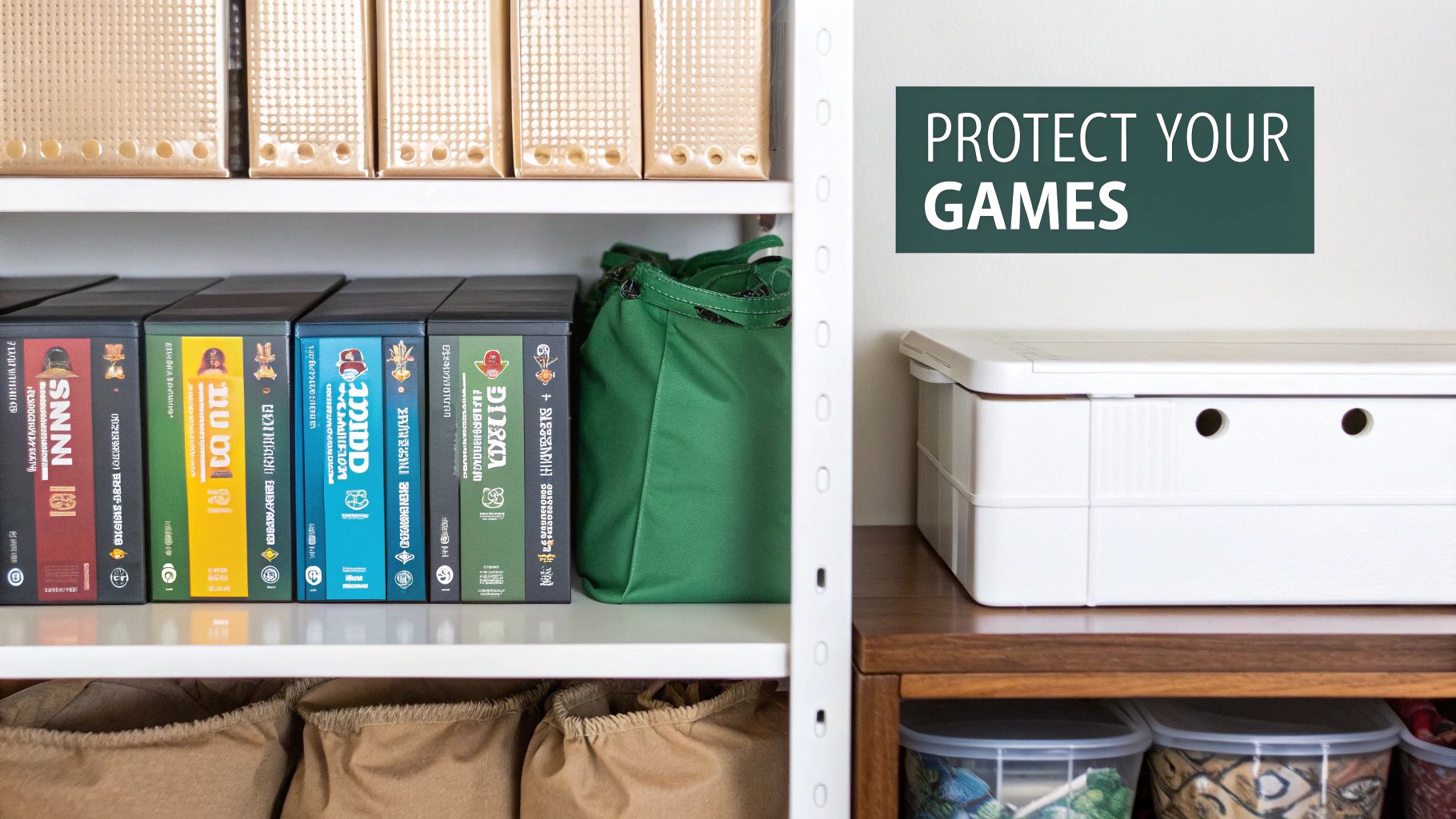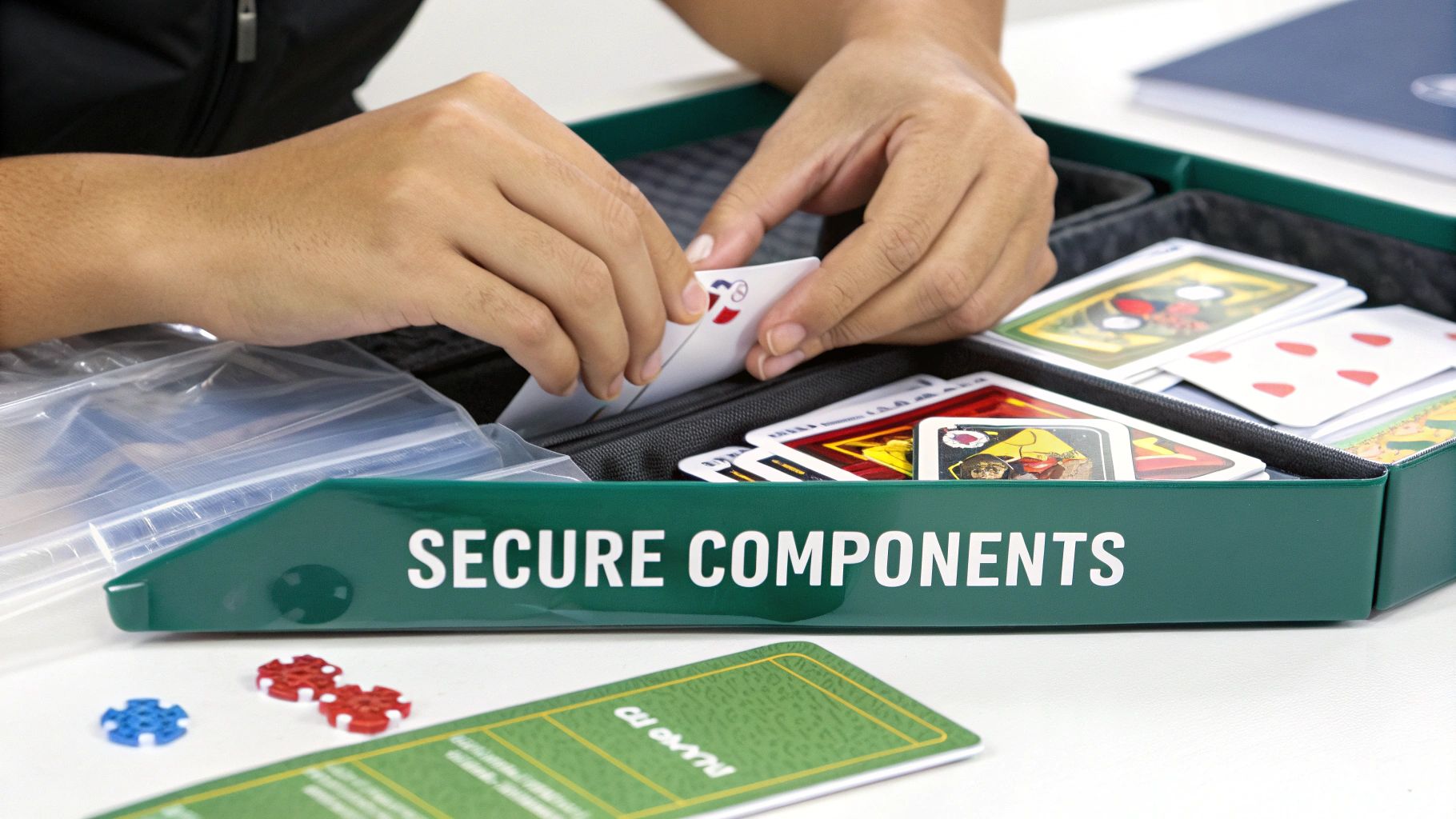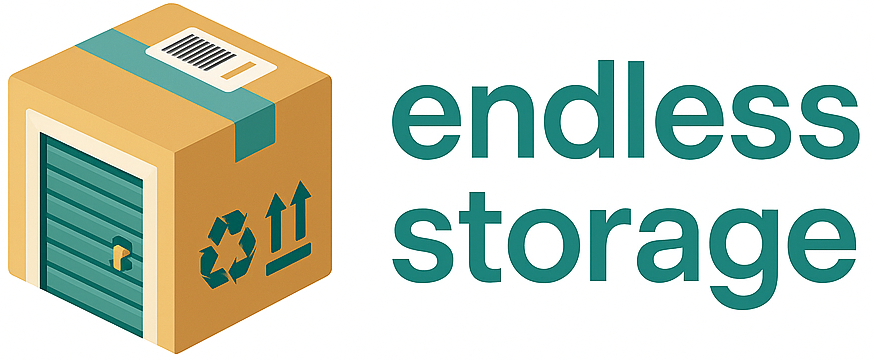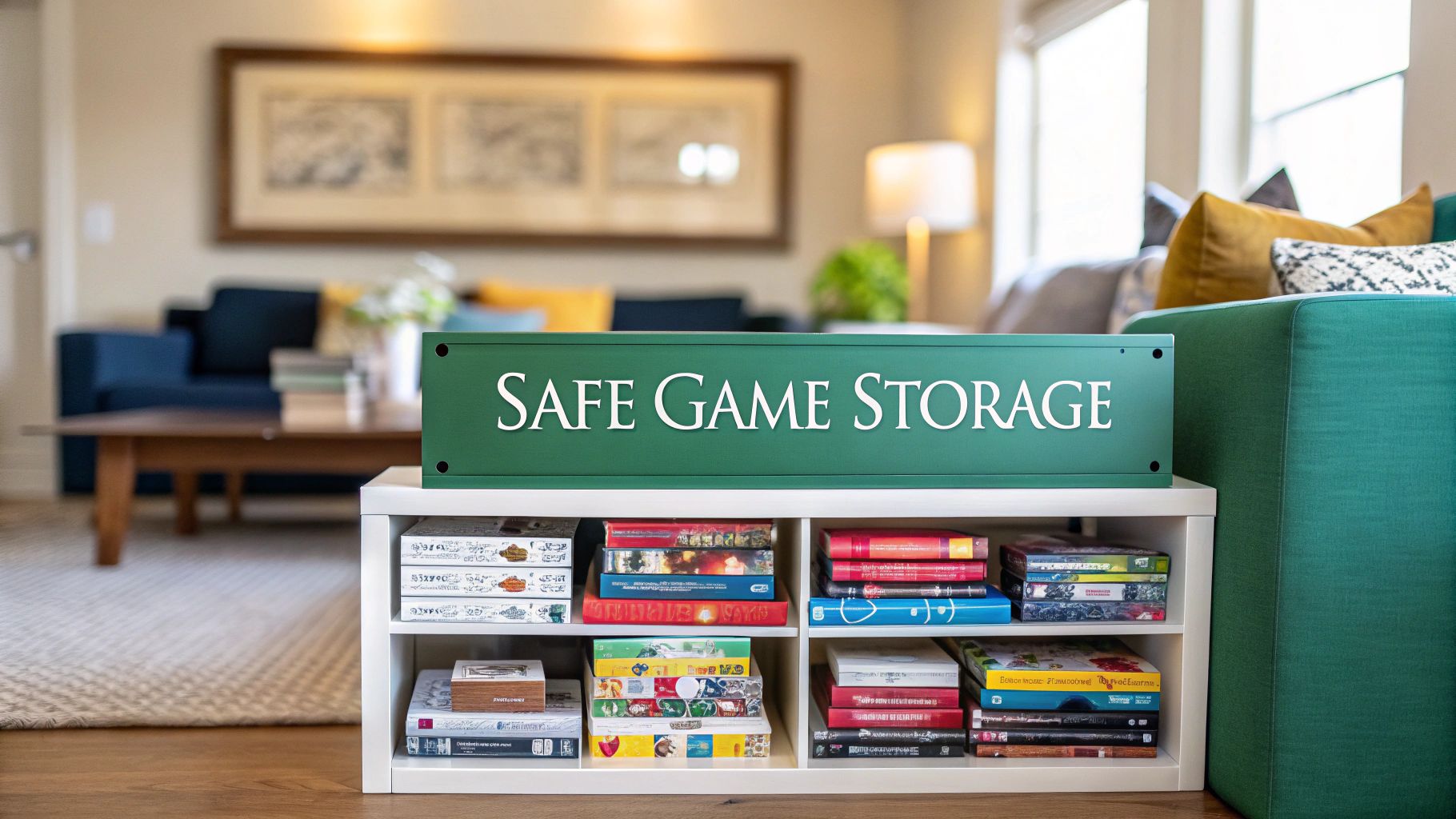Storing your board games the right way means thinking about the long haul. It's about finding a stable, climate-controlled spot and prepping your collection for its stay. This goes beyond just being tidy—it's about bagging loose components, reinforcing weaker boxes, and choosing a dry closet over a damp basement to preserve the games you love for years.
Protecting Your Collection From Day One
Knowing how to store your board games has never been more important. The hobby is absolutely booming, and collections are growing faster than ever. Suddenly, that Kallax shelf is full, and what was a fun pastime is now a serious logistical puzzle. This isn't just about finding a home for one more box; it’s about safeguarding a valuable—and often sentimental—investment.

Why Proper Storage Matters
Without a solid plan, your games are at the mercy of the elements. Humidity, big temperature swings, and physical stress can wreak havoc. Warped boards, mildewed cards, and crushed boxes don't just ruin a game's playability—they can send its value plummeting.
The good news is that the core principles of proper storage are universal, whether you own ten games or several hundred. The fundamentals are a lot like those for learning how to store collectibles of any kind, with a laser focus on preservation and easy access.
The global board games market is projected to skyrocket to USD 23.8 billion by 2035, and it's not hard to see why. Believe it or not, nearly 11% of gamers own more than 100 games each. This rapid growth just underscores the need for smart, effective ways to protect and organize these ever-expanding libraries.
To give you a clear starting point, I've broken down the absolute essentials of game storage in the table below. From creating the ideal environment to smart organization tricks, this will help you see what truly matters most.
Key Pillars of Board Game Storage
This table summarizes the most critical factors for successfully storing board games at home or in a storage unit.
Master these four pillars, and you're well on your way to building a storage system that will keep your collection safe and sound for the long run.
Prepping Your Games for Long-Term Safety
Before a board game ever touches a storage shelf, a little prep work can make all the difference. Think of it as preventative maintenance that guards against lost pieces and crushed boxes down the road. The goal here is simple: once that lid is on, everything inside should stay secure, contained, and ready for your next game night.

This initial effort is the real secret to avoiding the dreaded "component explosion"—that moment you open a game that's been stored vertically or moved around and find chaos inside. A few simple actions now will save you countless headaches later.
Secure All Loose Components
First things first: you have to contain all the little bits and pieces. Honestly, nothing is more frustrating than opening a box to find a jumbled mess of tokens, dice, and cards.
This is where small, clear ziplock bags become your best friend. Group similar components together—all the wood tokens in one bag, cardboard chits in another, and each player’s specific pieces in their own. It not only prevents damage from parts rattling around but also dramatically speeds up setup and teardown.
Pro Tip: Steer clear of standard rubber bands for your card decks. They can dry out, get brittle, and wreck the edges of your cards over time. Instead, look for acid-free paper bands or grab some dedicated plastic deck boxes to keep them neatly stacked and safe.
Reinforce and Protect the Box
A game’s box is its first line of defense, but let's be real, not all of them are built to last. Flimsy boxes are notorious for bowing, splitting at the corners, and getting crushed under the weight of other games. A bit of reinforcement, both inside and out, works wonders.
For the interior, you can make a simple support frame using foam core. Just cut strips to fit snugly along the inside walls of the box. This adds a ton of rigidity without adding much weight, borrowing a principle from our guide on how to pack fragile items for safe shipping.
On the outside, large, durable box bands are a fantastic investment. These elastic straps wrap around the whole box, keeping the lid locked down. This is absolutely critical if you plan to store your games vertically, as it stops the lid from sliding off and spilling everything.
Handle Complex Modern Games
The need for meticulous prep has really ramped up with the complexity of modern games. Massive titles like Frosthaven, which famously raised nearly $13 million on Kickstarter, often have hundreds of individual components. We're talking detailed miniatures, countless cards, and a sea of tokens.
This level of complexity makes robust, internal storage solutions pretty much essential for keeping the game in one piece and making setup manageable. When a game has that much going on, taking the time to bag and organize isn't just a good idea—it's a necessity.
Finding the Right Environment for Your Games
Where you decide to store your collection can literally be the difference between preservation and destruction. Too many collectors learn this the hard way after finding their prized games ruined by a place they thought was safe.
The usual suspects—attics, garages, and unfinished basements—might seem like convenient spots to stash your collection, but they are sworn enemies of cardboard and paper. These spaces are notorious for their wild temperature swings and oppressive humidity levels. In the summer, an attic can bake your games, causing boards to warp and box glue to fail. Come winter, that same garage can expose them to freezing temperatures, making plastic minis brittle and prone to snapping.
The Dangers of Humidity and Temperature
Of all the threats, the biggest one is moisture. A damp basement is a paradise for mildew and mold, which will permanently stain game components and leave a musty smell that you’ll never get rid of. This combination of heat and humidity essentially puts your collection on a fast track to aging and decay.
The golden rule is simple: store your board games in an environment you’d be comfortable living in yourself. You're aiming for a stable temperature between 60-75°F (15-24°C) with a relative humidity level between 40-55%. Consistency is everything.
It's the constant fluctuations that cause the real damage. Materials expand and contract with the changing conditions, leading to those dreaded warped boards and peeling box art. This is exactly why a bedroom closet or a shelf in your main living area is a far better choice. These spaces are already part of your home's climate-controlled environment, giving your games the stability they need to last. We go into a lot more detail on why this matters in our guide to climate-controlled self-storage.
Making Less-Than-Ideal Spaces Work
So, what if your only option is a room that’s a little… temperamental? All is not lost. You just have to take a few extra precautions to fight back against the environment.
If you’re stuck using a basement, investing in a good dehumidifier is non-negotiable. It’s the single best thing you can do. On the flip side, if you live in a very dry climate and are worried about components becoming brittle, some collectors even look into the best humidifiers for home to keep things balanced.
For an added layer of defense, put your games inside sealed plastic storage bins. Before you close them up, toss in a few silica gel packets—the kind you find in new shoe boxes—to absorb any trapped moisture. These small adjustments can make a huge difference in protecting your games from environmental damage, ensuring they stay in pristine condition for years of play.
The Great Stacking Debate: Vertical vs. Horizontal
Sooner or later, every board game collector hits a crossroads. Do you store your games vertically, like books on a shelf? Or do you stack them horizontally, like a pile of treasured pancakes?
This isn't just about making your game corner look good. The way you store your collection can seriously impact its condition and how easy it is to grab a game for your next session. There's no single "right" answer, but let's break down the pros and cons to figure out what makes the most sense for you.
Going Vertical: The Shelf-Appeal Method
Lining up games vertically is a fan favorite, and for good reason. It looks incredible, turning a simple shelf (like the iconic IKEA KALLAX) into a vibrant library of playable art.
The biggest win for vertical storage is accessibility. You can slide any game out from the middle of the shelf without having to unstack a single box. It completely eliminates that dreaded game of Jenga just to get to the one you want at the bottom of a pile.
But there’s a catch—what I like to call the "component avalanche." If you haven't properly prepped your games by bagging up loose pieces, gravity will do its thing. All those meeples, tokens, and cards will slump to the bottom of the box, creating a jumbled mess that can damage delicate bits and pieces over time.
Regardless of how you stack them, the environment is just as critical.

Keeping your games in a stable climate protects them from the silent killers: warping, fading, and mildew.
Making the Case for Stacking Horizontally
On the other side, you have horizontal stacking. This is, without a doubt, the safer option for the boxes themselves. The weight is distributed evenly across the entire base, which prevents the dreaded "dishing"—that awful sagging of the box lid you see when a game has been stored vertically for too long.
The logic here is a lot like what you'd see in guides on the best way to pack books, where the goal is to distribute weight and pressure evenly. Stacking flat is much kinder to your boxes, especially the flimsy ones or those with heavy components.
Of course, this method has its own set of rules. Stacking too high puts a ton of pressure on the games at the bottom, risking crushed corners and caved-in lids. As a rule of thumb, never stack more than three or four heavy games on top of one another.
Storage Orientation: Vertical vs. Horizontal
Deciding between vertical and horizontal storage can feel like a big commitment. Here’s a quick breakdown to help you compare them side-by-side.
Ultimately, the best choice really depends on the specific games in your collection and the kind of shelving you have.
So, What's the Right Choice for Your Collection?
For most people with a diverse collection, a hybrid approach is the most practical solution. You get the best of both worlds.
- Go Vertical for: Sturdy, standard-sized boxes that you’ve prepped with baggies and box bands. This is perfect for showcasing your collection on deep shelves.
- Go Horizontal for: Games with flimsy boxes, irregularly shaped containers, or extremely heavy components that would cause internal stress when stood on end.
With the board game market projected to hit USD 32.00 billion by 2032 and 27% of avid buyers purchasing over 30 titles a year, figuring out smart storage is more important than ever. Whether you choose vertical, horizontal, or a mix, the goal is always the same: to create a system that protects your games while keeping them ready for action.
Advanced Storage for Serious Collectors
There's a point every collector reaches when their single Kallax shelf starts to look less like a hobby and more like a structural support for the entire house. The casual system that worked when you had a dozen games just doesn't cut it when you're pushing fifty, or even a hundred. This is where you graduate from just stacking boxes to practicing true collection management.
The first step, and it's a big one, is simply knowing what you have. A sprawling collection can easily become a black hole where games disappear, only to be found years later. This is where digital tools become your best friend. An app like BGG Collection lets you log every single game, track where it’s stored, and even add notes about your last playthrough. It turns a daunting pile of cardboard into a searchable, sortable database—your command center.
Optimizing Your Game Boxes
With a serious collection, efficiency is everything. Let's be honest: the inserts that come in most game boxes are little more than cardboard trenches. They lead to a jumble of components and agonizingly long setup times. That's precisely why custom aftermarket inserts are such a worthwhile investment for a growing library.
These inserts, usually made from laser-cut wood or foam core, create a designated home for every token, card, and miniature. Yes, they add to the overall cost of a game, but the payoff is huge:
- Setup time gets slashed. Everything is pre-sorted and ready to hit the table.
- Your components are better protected. No more broken minis rattling around in the box.
- Vertical storage actually works. A good insert locks everything in place, even when a box is stored on its side.
I'd recommend starting with inserts for the games you play most often or the ones notorious for their fiddly setup. It completely transforms the experience from a chore into a joy. For those with truly massive collections, it can be helpful to look at how other hobbies manage their assets; exploring advanced organizational systems for collectibles can provide some great inspiration for handling thousands of individual pieces.
When Your Home Runs Out of Space
Sooner or later, even the most organized collector hits a wall—literally. When every closet is packed and the shelves are overflowing, it’s time to think about off-site solutions. This is where professional, climate-controlled storage becomes a genuinely practical option, especially if you have rare or valuable games in your collection.
A dedicated storage service isn't just about finding more room; it's about securing your investment in an optimal environment. It removes the risk of home-based environmental hazards like leaks, pests, or fluctuating humidity.
This kind of service is perfect for collectors who need to store a large part of their library long-term, want to rotate games seasonally, or simply need to protect their most valuable titles. Of course, when you're storing items of significant value, it's also smart to look into the details of insuring items in storage to make sure you're fully covered. By treating your collection with this level of care, you're no longer just owning games—you're actively curating and preserving a valuable library for years to come.
Common Questions About Storing Board Games
Even with the best game plan, some specific questions always pop up when you're figuring out how to store your collection. What do you do with that one weirdly shaped box? Are some games an absolute no-go for vertical storage? Let's dive into some of the most common challenges.
Think of this as a quick-fire problem-solving session. It's your go-to reference for those tricky situations that don't always fit neatly into a broader guide, helping you protect every single game, no matter how unique.
How Should I Store My Most Valuable Games?
When you’re talking about your grail games—the rare, out-of-print, or high-value stuff—you need to shift from thinking about simple storage to archival preservation. This requires an extra layer of protection.
First, wrap the entire game box in a high-quality, acid-free archival plastic bag or wrap. This creates a solid barrier against dust, moisture, and minor scuffs without risking damage to the box art over time.
For a game that represents a significant financial investment, storing it horizontally is almost always the best choice. This method provides the most support for the box structure, preventing any long-term sagging or stress that could diminish its condition and value.
Give these prized possessions a dedicated shelf. Ideally, not at the very top where heat tends to gather, or on the bottom where they're vulnerable to accidental kicks or spills. Don't cram them in, either—give them some breathing room.
What Is the Best Way to Handle Oddly Shaped Boxes?
Ah, the dreaded non-standard box. We've all been there. From the coffin-shaped box of Gloom to various tins and triangular containers, these are the rebels of the board game shelf. They defy neat stacking and create those frustrating gaps.
The key is to stop trying to force them in with your standard Kallax-fillers. Instead, give them their own dedicated space.
- Utilize Top Shelves: The tops of your shelving units are perfect for larger, awkwardly shaped boxes that you don't play as often.
- Use Bins or Baskets: Got a bunch of smaller odd-sized games, like those in tins? Grouping them in an open-top fabric bin or a wire basket keeps them contained and looking tidy.
- Stack Creatively (Horizontally): Find other similarly non-standard boxes and stack them horizontally together. It's a bit like a game of Tetris—find the pieces that fit to create a stable, if unusual, stack.
Whatever you do, don't force them into a spot where they clearly don't belong. Giving them their own zone keeps the rest of your collection from descending into chaos.
Will Sunlight Really Damage My Games?
Yes. Absolutely, unequivocally, 100% yes. Direct sunlight is one of the fastest ways to completely ruin a board game collection.
The ultraviolet (UV) rays in sunlight are incredibly destructive to the inks used in printing. Over time, that constant exposure will cause the vibrant colors on your box art and game boards to fade dramatically. You're left with a collection that looks washed-out and old. Worse, this damage is irreversible and tanks a game's resale value.
Always, always position your game shelves away from windows that get direct sunlight. If that’s just not possible in your space, look into UV-blocking window film or simply keep the blinds drawn during the brightest parts of the day. A little prevention here goes a very long way in preserving the beautiful artwork that makes your collection special.
Are you running out of shelf space faster than you can play your games? Endless Storage offers a simple, secure solution. We send you custom boxes, you pack your games, and we store them in our climate-controlled facility until you need them next. Free up your living space and protect your collection by visiting us at https://www.endless-storage.com to get started.
Frequently Asked Questions
Unveiling the Secrets to Effortless Storage
Endless Storage is available nationwide. You pick a plan, tell us where to pickup, and we'll send a UPS van to collect, whichever state you're in.
Your shipping label will be sent to your email within a few minutes, if not instantaneously. It can also be accessed through your customer profile.
Your box will be shipped to one of our climate controlled self storage facilities in our closest self storage facility. Our manager will accept your package, notify you that your box has been received, and securely stored. Only our managers will have access to Endless Storage boxes.
Email us at admin@endless-storage.com click to live chat with us, or send us a message below.
Never! We're committed to transparent pricing with no surprises. You'll lock in your rate with no hidden fees and no long-term contracts.
Fast access guaranteed! Your boxes will arrive at your doorstep within 48 hours of requesting them back. Need to check on delivery? We provide tracking information for complete peace of mind.
Totally flexible! Store month-to-month with no long-term commitment and cancel anytime.
Everything's online! Use your account dashboard to:
• Set up automatic monthly payments
• Request box returns
• Update your address
• Order additional boxes
• Track shipments
Your boxes are insured up to $100 each. Our customer service team will help you file any necessary claims and resolve issues quickly.
Don't worry – we'll email you right away if there's a payment issue. Your items stay safe, though you may have temporary service interruption or late fees until payment is resolved.
When you request our free storage kits, you'll have 30 days to send in your boxes to activate your 3 months of free storage. Think of it like starting a gym membership – your activation window begins when you receive your kits, and your full free trial begins once you send in your first box. During your free months, you'll experience our complete storage service at no cost.
Your 30-day activation window begins when you receive your storage kits. We'll send you an email confirmation when your kits are delivered, marking the start of your activation period.
If you haven't sent any boxes for storage within your 30-day activation window, your free trial will expire and we'll begin charging the regular monthly rate of $9.99 per box. This helps ensure our storage kits go to customers who are ready to use our service.
A box costs $9.99 per month to store (plus sales tax). This price includes free shipping for standard boxes under 50 lbs. and smaller than 16"x16"x16"
Log into your Endless Storage account, locate the box you would like returned, and simply click Return My Box.
Yes, each box stored with us is insured for up to $100 throughout transit as well as the duration of storage within our facilities.
Your box will be at your doorstep within 48 hours of you requesting it back.
Store 10+ boxes? We'll pick them up for free! After your purchase, we'll contact you to schedule a convenient pickup time and arrange UPS collection.
We trust UPS with all shipments, and every box includes $100 insurance coverage. You'll receive tracking information to monitor your items' journey.
Yes! Visit any of our locations by appointment. Just bring a photo ID matching your customer profile.
For everyone's safety, we can't store hazardous materials, firearms, or perishables. All items must fit within our standard boxes.
It's easy! Order your storage kit online, and we'll ship it to you within 1-2 business days. Your shipping labels will be emailed instantly and available in your account.
We're here to help! Email us at admin@endless-storage.com, use our live chat, or send us a message through your account.
To cancel your storage service with Endless Storage, please email your cancellation request to admin@endless-storage.com. Our team will process your request within 2 business days and confirm your cancellation via email.
We understand packing takes time. However, to maintain your free trial benefits, you'll need to send at least one box within the 30-day activation window. If you need more time, you can always start with one box to activate your trial and send the rest later. You can always reach out to admin@endless-storage.com if you have any issues or concerns.
When you request our free storage kits, you're starting a 30-day window to begin using our storage service.
To avoid any charges, simply send at least one box for storage within 30 days to activate your 3-month free trial. If you decide not to use our service and don't send any boxes within the 30-day window, a one-time $50 fee will apply to cover the costs of materials and shipping. This helps ensure our storage kits go to customers who are ready to use our service.
Think of it like reserving a hotel room – we're setting aside space and sending specialized packing materials for your use. The fee only applies if you request materials but don't begin storage, similar to a hotel's no-show charge.

